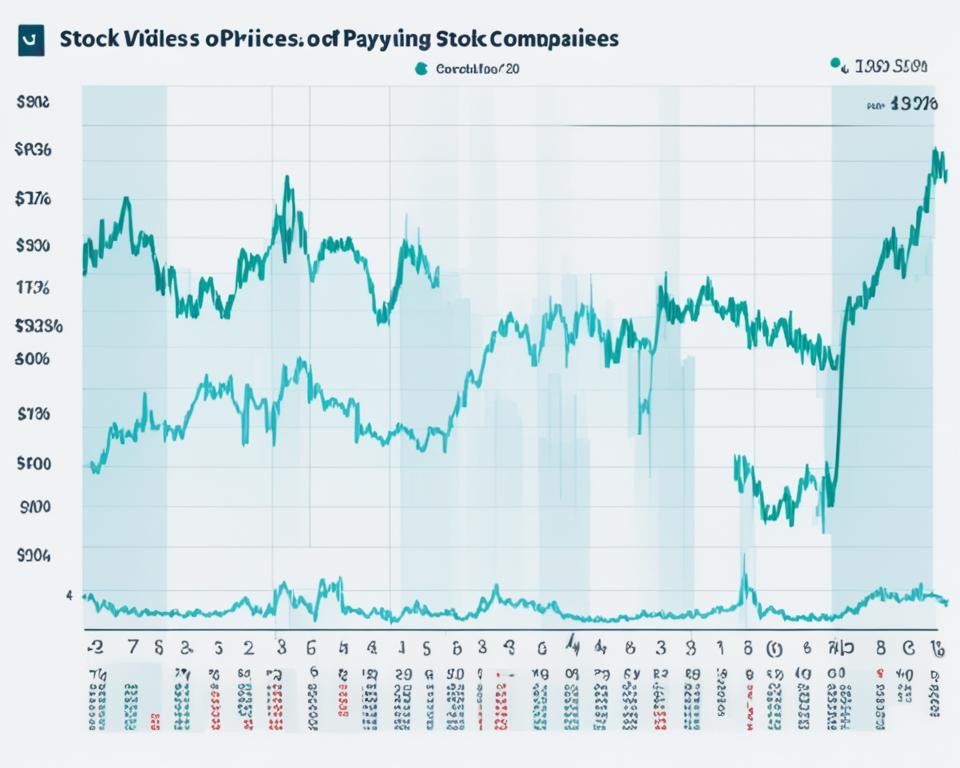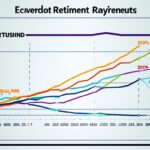As an investor, you might be well aware of the complexities of the dividend stock market trends that swing with economic changes. In an era where inflation spikes and certain stock prices witness dips, you’re probably considering investing in dividend stocks as a safe harbor. Not merely a trend, these dividend-paying stocks experiencing significant price fluctuations offer a blend of potential income and stability that might be just what your portfolio needs during volatile market conditions.
Understanding how dividends can act as a counterbalance during these high tides of the market can grant you peace of mind. It’s about striking the right chord between seeking growth and securing income. Let’s delve into why now might be a prudent time to get acquainted with the robust world of dividend-paying stocks.
Key Takeaways
- High inflation can bolster the appeal of dividend stocks, which have historically accounted for 40% of stock market returns since 1930.
- Stocks that intensify their dividends during inflationary periods often outshine the general market performance.
- Dividend stock market trends indicate stability, with dividends contributing to less volatile total returns.
- Investing in dividend stocks provides not just income but also a potential hedge against inflation.
- Properly chosen dividend-paying stocks can be a key addition to diversify your investment strategy amidst market unpredictability.
The Relationship Between Dividends and Stock Price Volatility
When navigating the ocean of the stock market, savvy investors often anchor their portfolios with dividend-paying stocks experiencing significant price fluctuations. On the surface, these fluctuations may appear daunting, but understanding the intrinsic value of dividends may illuminate their stabilizing presence amid stock market volatility. Before we dive deeper into the sea of dividends and their stabilizing characteristics, let’s explore their foundational impact on stock stability and inflation’s role in this dynamic.
Understanding How Dividends Contribute to Stock Stability
Consider dividends as buoys in turbulent waters, providing steady income that can create a calming effect on a stock’s total return. Particularly during shaky market conditions, dividends offer a glimpse of predictability, could enhance investor confidence, and may potentially ripple out to curb stock price volatility. It’s akin to a recurring reward for investors who remain aboard amidst the ebb and flow of share prices, reinforcing the stock’s foundation with a base level of expected return.
Assessing the Impact of High Inflation on Dividend Stocks
Inflation—a specter that can erode the purchasing power of your investments—poses a unique challenge, often sending shockwaves through the stock market. Nevertheless, businesses adept at adjusting their sails by increasing dividend payouts may forge ahead of the market’s tumultuous winds. These are the high-yield investments that not only endure the high tide of inflation but also allow investors to harbor hopes of consistent cash flow, which could be instrumental when stock prices are adrift from their peaks.
In times of inflation, which corp. captains do you trust to navigate the economic tempest? Industries that can raise their prices often reflect the endurance of their dividends. These corporates, displaying an ability to pump their dividends upwards, become the sought-after vessels in the fleet of the stock market. Their dividends may evolve into a beacon of growth potential, steering stock prices towards calmer waters, even when the market seems submerged in uncertainty.
Remember, during bygone eras marked by immense stock market volatility—the 1930s and the early 2000s—dividends have played the role of lifesavers, nearly countering the descent of the S&P 500 index. It’s a clear demonstration of dividends offering a lifeline, keeping investment portfolios afloat during the stock market’s stormy seasons.
As we venture through the currents of the financial markets, our course is clear: dividends, especially those from reliable corporates with the agility to adapt and prosper, can serve as stabilizing forces for your investment voyage. Seek out those dividend-paying stocks with histories of weathering the changing tides of inflation—they may just be the key to a more resilient and high-yield investment experience.
Historical Performance of Dividend Stocks During Market Fluctuations
When you look back over the decades, there’s a discernible pattern that shows dividend growth potential as a solid player during unpredictable economic episodes. It’s been this way since well before modern investment tactics took shape. Think about the long-term dividend investing strategy—it has withstood the test of time, delivering shareholder value even when broader market indices have stumbled.
Reflect on the 1930s and the early 2000s, for example, when global economic downturns and stock market turmoil occurred. Dividend-paying stocks have emerged not only as a vital source of income but also as tools for softening the blows from market downturns. This isn’t just happenstance; it’s a result of companies that maintain stable dividends and thus secure shareholders’ trust in their ability to weather economic storms.
During periods like the 1940s and 1970s, when inflation had its grip tight on the economy, resulting in increased costs of goods and dwindling purchasing power, those holding dividend stocks saw a significant part of their returns—65% and 71%, respectively—come from those dividends. This is not a small feat, and it underpins the proposition that dividends may provide some insulation against the market’s tremors.
Your investment portfolio aiming for dividend growth potential will find reassurance in historical data if you’re considering long-term dividend investing. It’s essential to delve into the stories these numbers tell. But how do you interpret this data to align it with your current investment objectives?
Let’s bring this into perspective with an illustration:
| Decade | Inflation Rate | Dividend Contribution to S&P 500 Return |
|---|---|---|
| 1930s | Low-Moderate | Nearly Balanced Net Returns |
| 1940s | High (avg 5%+) | 65% |
| 1970s | High (avg 5%+) | 71% |
| Early 2000s | Low-Moderate | Offset Price Declines |
This table isn’t just a collection of statistics—it’s a roadmap showing that dividends did not flinch when faced with inflationary headwinds. They’ve demonstrated a capacity to stand firm and deliver returns that can be a beacon for those navigating through the stormier periods of market volatility.
The essence of what you’re witnessing within this snapshot of time is the enduring nature of dividends as a component of return on investment. Whether you’re nearing retirement or building the foundation of your investment portfolio, these insights into dividends are nuggets of wisdom worth their weight in financial security.
The takeaway for you, as an investor, is clear: there’s solace in the historical performance of dividend stocks amidst market fluctuations—and perhaps a silver lining during times of economic uncertainty.
Identifying Dividend-Paying Stocks with Recent Price Swings
As you embark on investing in dividend stocks, discerning the patterns of price fluctuations becomes a crucial skill. Just like a detective follows the traces to solve a mystery, your quest in dividend stock analysis involves piecing together historical trends and market signals. With the right approach, you’ll uncover the stocks that not only pay dividends but also display price resilience or recovery potential in the face of market volatility. So, let’s unravel the factors that contribute to these swings and learn how to spot the opportunities they may present.
Case Studies: Dividend Stocks and Their Price Behavior
Consider the energy sector, which, in recent times, has shown a leading pace in dividend growth. Look at the well-established players like Chevron and Exxon Mobil. Despite the volatility in oil prices affected by global events, these energy giants have consistently maintained and increased their dividends. It’s reflective of their strong business fundamentals and ability to generate substantial cash flow, even when the dividend stock market trends sway. Their history suggests resilience and a commitment to shareholders returns during all market conditions. By analyzing such case studies, you can gage which stocks are likely to continue providing dividends during market gyrations.
How to Spot Trends in Dividend Stocks and Volatility
To spot lucrative trends, you might focus on sectors known for dividend robustness. Take, for instance, consumer staples and utilities, sectors traditionally seen as defensive during economic downturns. Companies within these industries often have pricing power which allows them to pass increased costs to consumers, thereby maintaining profits and dividend payouts. By closely observing these patterns, you can better navigate your investment journey towards stocks with the potential to sustain and grow dividends against inflationary pressures.
Employing a refined lens of analysis, you can move beyond surface-level yardsticks to identify players with strong pricing power and an established record of cash flow growth. This becomes distinctly valuable when exploring industries with intrinsic volatility, such as technology, where shifts are rapid, but so are the opportunities for dividend growth. Your goal is to create a well-balanced portfolio that can weather the stormy seas of the dividend stock market trends, ensuring a steady income stream and growth potential.
And remember, while professional fund managers have tools at their disposal to navigate these waters successfully, individual investors like you are not without recourse. Fundamental analysis, attention to corporate news, and an unwavering eye on dividend stock market trends will serve as your compass in the pursuit of dividend-paying stocks capable of turning tides of volatility into valuable investment horizons.
Dividend Growth Potential Amidst Economic Shifts
Shifts in the economic landscape can often bring waves of uncertainty to the stock market, prompting investors to seek out high-yield investments with stability. In this environment, honing in on companies that boast a track record of dividend growth potential can be particularly prudent. These institutions are not mere safe harbors, but beacons of growth, signaling the robust health and earnings potential that income-focused investors are seeking. With a strategic focus on long-term dividend investing, you may discover investments that reliably increase dividends, offering you the dual benefit of income generation alongside the possibility of capital appreciation.
Let’s examine how these companies serve as stalwarts in your portfolio, fortifying against economic headwinds:
Evaluating Companies That Consistently Raise Dividends
Finding and investing in companies with a consistent record of raising dividends can be likened to identifying strong ships that stand steady even as the economic sea churns around them. These are the hallmark investments that often promise not only regular income but also speak to the resilience of a business. Historically, companies that increase dividends have provided a signal to the market of their good financial standing and the foresight to sustain dividends even when times get tough.

The Role of Dividend Growth in Mitigating Price Fluctuations
Regular dividend increases from such pillars of the investment world can serve as a cushion against price volatility. In essence, companies that systematically grow their dividends yield more than just monetary returns. They exude strength and a defensive posture amidst the ebb and flow of market prices. The concept here is simple yet profound: a commitment to dividend growth often corresponds to an intrinsic value that may support the stock price during downward shifts, providing a level of predictability and financial comfort to you, the investor.
Whether used to reinvest or taken as cash, these growing dividends compound over time, further entrenching the appeal of long-term dividend investing. As we steer through the ever-shifting waters of the economy, embracing the inherent stability offered by growing dividends could very well differentiate your investment journey from a tumultuous voyage to a strategic, prosperous journey.
Reflecting on these insights helps to underscore the impact and importance of dividends within your investment strategy. It illustrates the potential of well-chosen dividend payers to offer not just stability and income, but a hopeful trajectory of growth and financial well-being over time.
Stock Market Volatility: Navigating the Uncertain Waters
When the financial forecasts call for stock market volatility, it’s time to consider anchoring your investment portfolio with high-yield investments. Dividend stocks stand out as a beacon during turbulent times, often holding the potential to steady your financial ship.
As you traverse through choppy market seas, it’s no secret that investing in dividend stocks can be a wise strategy to not only pursue growth but also to tap into a source of consistent income. Why? Because historical insights reveal that during periods of turmoil, these stocks can provide a much-needed buffer against the tides of economic instability.
One compelling reason to leverage dividend stocks in a volatile environment is their unique ability to act as both a running mate in good times and a safe haven when the waters get rough. In other words, companies with a history of steady dividend payments tend to exude a level of reliability coveted by investors—especially when the market is on a rollercoaster ride.
But diving into dividend investing isn’t just about grabbing any life jacket—it’s about finding the right fit for your financial goals and risk appetite. This quest calls for due diligence and a strategic approach to weather potential market storms—where companies that consistently increase their dividends sail to the top of your consideration list.
Consider the following keywords as beacons in the night: stock market volatility, investing in dividend stocks, high-yield investments. They are your guiding stars, helping you pinpoint the vessels in the vast investment ocean that can lead you to calmer waters—or better yet, to lucrative destinations.
It’s essential to not just understand the concept of dividends but to know how to harness their power effectively. Here lies the craft of portfolio management that balances steady dividend payers with growth-oriented investments. The art is in understanding and acting on market signals that dictate when to hold steady and when to adjust your sails.
To help you steer your investment course with confidence, the following table juxtaposes dividend yield and stock market volatility, providing insights into potential investment strategies. This isn’t simply a table; it’s a compass for your investment journey:
| Market Condition | Dividend Yield Impact | Investment Strategy |
|---|---|---|
| Calm Waters (Stable Market) | Moderate Appeal | Diversify with growth and dividend stocks |
| Rough Seas (High Volatility) | Increased Appeal | Seek high-yield dividend stocks |
| High Winds (Inflationary Market) | Preferred Harbor | Focus on dividend growth stocks |
| Uncharted Territory (Uncertain Market) | Crucial Lifeline | Anchor with reliable dividend payers |
Amid all this, remember that big waves can wash over even the sturdiest of ships. Hence, it’s vital to ensure your portfolio doesn’t lean too heavily on one sector or investment type. A diversified portfolio is your best shipmate on this financial voyage—one that can mitigate risks and harness the potential of high-yield investments to provide smoother sailing towards your investment horizon.
As we continue to navigate these uncertain waters, let us be your lighthouse, guiding you with insights and strategies that empower you to invest with vision, seize opportunities, and sail towards your desired financial future, irrespective of the volatility that may lie ahead.
Examining the Role of Dividend Aristocrats in a Volatile Market
For investors aiming to fortify their portfolios against the waves of volatility, particularly when dealing with dividend-paying stocks experiencing significant price fluctuations, a closer look at Dividend Aristocrats might illuminate a path to stability and reliable returns. With a track record that often sails smoothly through economic squalls and market downturns, these companies are cornerstones for dividend stock portfolio management.
History and Reliability of Dividend Aristocrats
Renowned for their resilience, Dividend Aristocrats are a storied fleet in the market, with each having raised its sails—that is, its dividends—for at least a quarter-century consecutively. These bastions of persistence are not simply drifting along; they’re moving with purposeful strides, evidencing a commitment to their shareholders that runs deeper than surface-level market trends.
Companies like Procter & Gamble, Johnson & Johnson, and Coca-Cola represent some of the esteemed names that have weathered storms to offer consistent shareholder value. Their historical performance is a testament to their financial fortitude, underpinning a strategic approach to managing a dividend stock portfolio that aims for longevity and stability.
Comparing Dividend Aristocrats to the Broader Market During Downturns
It’s one thing to charter a course during calm seas, but the true test comes when the tides turn tumultuous. Here, Dividend Aristocrats have shown their mettle. When companies such as Walgreens Boots Alliance falter and cut dividends, thus being cast away from the Aristocrats index, the selective nature of this elite group is underscored.
On the other hand, the addition of Fastenal to the Dividend Aristocrats signals a recognition of consistent performance amid industry ebbs and flows. For the investor navigating uncertain climates, these companies can serve as a lighthouse, guiding through a fog of stock market volatility and helping chart a course towards a more confident investment strategy.
Building a High-Yield Investment Portfolio with Dividend Stocks
Embarking on the journey of dividend stock portfolio management is akin to charting a course through the high seas of the financial market. To fortify your investment vessel against the torrent of stock market variances, incorporating high-yield investments through a selection of dividend-bearing stocks is essential. It is not just about anchoring in the harbor of high yields but also about setting the sails to capture growth winds, ensuring a balanced journey through dividend-paying stocks experiencing significant price fluctuations.
Strategies for Selecting High-Dividend Stocks
When selecting stocks that promise attractive dividends, it’s crucial to cast a wide net across various sectors and industries to diversify. Investing in dividend stocks commands a thorough scrutiny of the company’s dividend history and financial fortitude, meticulously distinguishing high yields that signify prosperity from those that wave red flags of caution. Diving into financial reports and earning statements provides insights into the sustainability of a company’s dividend payments, revealing whether high yields are maintainable or just masts waiting to snap in the gale of economic downturns.
Balancing Yield and Growth in Your Dividend Investments
To navigate the waters of dividend stock portfolio management successfully, balancing the allure of high yields with the promise of growth is imperative. Appraising the payout ratio serves as a compass to this effect, indicating whether a stock’s dividend is a beacon of stability or a signal flag for potential cuts. The lower the payout ratio, the less earnings are being paid out as dividends, implying that the company has ample room to grow dividends or weather fiscal storms. Conversely, a high payout ratio could indicate that a company is paying out more than it can afford, foreshadowing rough seas ahead.
Investors like you can embark on the quest for high-yield investments by hoisting sails in either individual dividend-paying stocks or by joining a convoy of passive index funds and ETFs. While passive funds charter a course along the market currents with low expense ratios, actively managed funds can maneuver through the swells to seize stocks poised for dividend increases. All strategies direct towards the same horizon—to amplify dividend income while preventing your portfolio from being capsized by significant price fluctuations.
As you navigate these investment waters, remember that the voyage to a robust dividend portfolio is not without the risks of stormy markets. Assessing each stock’s ability to maintain and grow dividends ensures that your portfolio is not just a mighty ship but one with the resilience to withstand the rough tides of economic shifts and the agility to swiftly catch the tailwinds of market recovery.
Analysing Dividend Stock Prices Post-Ex-Dividend Date
If you’re delving into dividend stock analysis, you’ll notice that dividend-paying stocks often witness a particular cadence around their ex-dividend date, impacting their stock prices with significant tempo. It can frequently be observed that following the ex-dividend date, these stocks experience price adjustments, typically with a drop nearly equivalent to the dividend amount paid out.

This predictable dance between dividend payments and stock price moves is a crucial rhythm to comprehend, especially when you’re looking to fine-tune your portfolio with dividend-paying stocks experiencing significant price fluctuations. Grasping this pattern is not just about market observation—it’s a strategic tool guiding your decisions on the most opportune moments to dive into and out of these investments.
When a company distributes dividends, the allure for investors is undeniable. However, it’s the subsequent ebb in stock price post-ex-dividend date that should pique an analytic mind, serving as a map to these investment islands.
Let’s examine a typical scenario: A company’s stock trades at $50 per share with a slated dividend of $1 per share. Post-ex-dividend date, the stock might be expected to tilt the scales at around $49, theoretically speaking. Yet, the actual pricing outcome post-dividend depends on a symphony of market variables—all orchestrated in the grand concerto of the stock market.
- Valuation of current shareholders’ entitlement to the impending dividend.
- Market sentiment and broader economic indicators leading up to the ex-dividend.
- Investor scrutiny of company performance and future dividend expectations.
Aligning your strategy with these market movements can be the difference between a well-timed investment and a misstep. As you watch these dividend-paying stocks experiencing significant price fluctuations, consider them not as riptides to be wary of but as waves that, when ridden with insight, could lead you toward profit shores.
Dividend Stock Portfolio Management During Price Fluctuations
As the waters of stock market volatility churn, your approach to dividend stock portfolio management must be both sturdy and adaptable. Aligning your sails with the changing winds involves more than just seeking refuge in high-yield dividends; it involves a keen eye on diversification and periodic reassessment of your holdings. Let’s explore how to stay the course with strategic insights into longevity and growth within your dividend portfolio.
Maintaining a Diversified Portfolio for Longevity
To build a dividend portfolio that can withstand the ebb and flow of the markets, spreading your investment across various sectors and industries is key. This not only helps in mitigating risk but also positions you to take advantage of different economic cycles and sector performances. A portfolio composed of consumer goods, utilities, health care, and technology can offer more stable ground—a necessary counterbalance against stock market volatility.
The Importance of Reassessment and Rebalancing
Staying vigilant is a crucial component of your investment voyage. Regular reassessment of your portfolio helps to ensure that each stock aligns with your objectives for long-term dividend investing. Look beyond the enticing high dividends and delve into fundamentals such as the payout ratio and the sustainability of cash flows. Stress test these ratios to sail away from potential dividend cuts and adjustments that may sink your income stream.
Furthermore, rebalancing your holdings periodically in response to ever-shifting market tides is just as important. It’s not enough to merely set sail; you must navigate according to the changing conditions. There may be times when trimming sails from over-performing sectors and directing them towards undervalued areas will create a more harmonious balance, reducing the impact of unexpected market swells.
The aligning table showcases an example of how to balance your portfolio by industry sector for enhanced stability:
| Sector | % of Portfolio | Reason for Inclusion |
|---|---|---|
| Utilities | 20% | Stable dividends, lower volatility |
| Health Care | 20% | Demand consistency, resilient dividends |
| Consumer Goods | 20% | Essential products, reliable dividends |
| Technology | 15% | Growth potential, increasing dividends |
| Financials | 10% | Interest rate beneficiaries, strong dividends |
| Industrials | 10% | Cyclical growth, diversification |
| Energy | 5% | Commodity price leverage, high yield potential |
By marinating a diverse array of sectors in your portfolio, you ensure that while some may face the headwinds of change, others can catch the growth breeze, reinforcing the overall stability and endurance of your investments. This, dear navigator of the markets, is the essence of crafty dividend stock portfolio management—a guiding star for those who pursue the treasure of a resilient, income-generating portfolio.
Investing in Dividend Stocks: A Haven in Stormy Markets?
When financial skies grow dark and stock markets roil with uncertainty, many investors turn their gaze toward the steadier glow of dividend-paying stocks. Such stocks serve as a beacon to those seeking not just profitability, but also a measure of protection from the torrential downpours of market instability. In the quest for financial serenity, recognizing the inherent value in investing in dividend stocks can be equivalent to finding a safe haven in stormy markets.
The Search for Stability: Dividend Stocks vs. Growth Stocks
The debate between the merits of dividend stocks versus growth stocks is an enduring one, but the scales tip noticeably during volatile times. While growth stocks often dazzle with their promise of substantial future gains, dividend stocks extend a comforting hand with the potential for regular income paired with capital appreciation. Unlike their high-flying counterparts, dividend-paying stocks experiencing significant price fluctuations can offer a more predictable and moderate path forward through their payouts, leaving investors less exposed to the whims of market sentiment.
As you weigh your options, remember that a stock’s price may ebb and flow, but dividends from steadfast companies tend to flow more steadily. This can be instrumental in crafting a high-yield investment portfolio that not only aims for growth but also prizes income generation—even amidst the market’s caprice.
How Dividends Provide a Buffer Against Market Downturns
In the throes of market downturns, dividends stand out as a resilient layer of defense for investors’ portfolios. The magic of dividends lies in their dual ability to contribute to an investment’s total return while also shielding the investor from the full brunt of any stock price declines. When the sea of price charts turns tumultuous, the calming current of dividend income helps maintain an even keel for your financial vessel.
By fortifying your holdings with companies known for reliable dividends, you’re not just playing defense. You’re embracing a strategy that seeks to sustain and even enhance your portfolio’s value, offsetting the often-unsettling effects of stock market volatility. The combination of income and potential for appreciation underscores the entwined strength that high-yield investments may offer to your long-term investment journey.
Measuring the Impact of Dividends on Total Return
When you’re investing in dividend stocks, it’s not just the short-term gain that you should be considering; it’s the long haul where the true impact of dividends shine, illuminating the path to significant total returns. Indeed, dividends become the cornerstone for those seeking both income and growth—hallmarks of high-yield investments and dividend growth potential.
But how do you quantify this impact? Let’s dissect the key indicators that serve as navigational aids on this voyage: the dividend yield, dividends per share, and the dividend payout ratio, each a beacon that can guide your investment decisions towards more lucrative outcomes.
Dividend Yield: Your Annual Income per Dollar Invested
The dividend yield is akin to the current that propels your investment forward: the higher the yield, the stronger the push. It represents the percentage of your investment that is returned to you in the form of dividends and is a vital metric to assess the income-producing potential relative to the stock’s price.
| Company | Annual Dividend | Stock Price | Dividend Yield |
|---|---|---|---|
| Company A | $1.20 | $40 | 3% |
| Company B | $2.50 | $100 | 2.5% |
In the table above, you can observe how the dividend yield is calculated and how different yields stack against each other. By benchmarking these percentages, you’re better positioned to choose high-yield investments that align with your goals for dividend growth potential.
Dividends Per Share: The Paddle in Your Investment Canoe
Equally revealing is the measure of dividends per share, offering a concrete figure to add to your investment ledger. This metric shows the actual dollar amount each share brings you in dividends. When combined with the dividend yield, it paints a more detailed portrait of your prospective income stream.
Dividend Payout Ratio: The Sail Adjusted for Financial Health
Your ability to foresee the durability of a dividend payout comes through understanding the dividend payout ratio. It indicates what portion of earnings a company pays out as dividends. A sustainable ratio implies a ship that can withstand rough seas without sacrificing its cargo, hence maintaining or increasing future dividends.
To continue your journey through investing in dividend stocks, these three metrics—dividend yield, dividends per share, and dividend payout ratio—form a triangulation method to ascertain which high-dividend stocks might be hidden treasures or sunken ships. As you gauge each metric’s horizon, you ensure that the returns you seek are more than just a mirage but are indeed a tangible destination in your investment quest.
Timely Insights on Dividend Stock Market Trends
In the realm of investment where stability intersects with growth, dividend-paying stocks experiencing significant price fluctuations stand as beacons for astute investors. The unpredictable waves of the dividend stock market trends necessitate a keen eye on the economic horizon, ensuring that one’s investment strategies are anchored by informed decisions and timely insights.
Economic Indicators Influencing Dividend Stocks
Navigating through the dynamic seas of the stock market, investors like you understand the importance of monitoring economic indicators. Inflation rates, the elasticity of interest rates, and nuanced sector performances play critical roles in charting the course for dividend-paying stocks. Whether it’s the announcements from the Federal Reserve or shifts in consumer demand, these indicators serve as lighthouses, guiding you toward safer investment havens and steering you away from potential storms.
Capitalizing on Dividend Opportunities in the Current Climate
The current investment climate offers unique opportunities for those seeking to diversify with dividend-yielding stocks. With the ever-present threat of inflation, sectors that historically have strong pricing power, such as utilities and consumer goods, become attractive harbors for your capital. The capability of these industries to ride the wave of price hikes and maintain dividend payouts positions them as appealing choices in a portfolio designed for resilience and consistent returns.

Furthermore, it’s an opportune moment to analyze companies that are demonstrating robust fundamentals and staunch cash flows, even amidst market turbulence. These factors often predicate the ability of a company to not only sustain but potentially raise its dividend yield, rendering its stock a frontline contender for your investment attention. By prudently capitalizing on the current climate and its dividend opportunities, you shore up your investment portfolio against the unpredictability of market volatility.
Dividend Stock Analysis: Beyond Basics
When you peel back the layers of surface-level metrics, dividend stock analysis becomes a beacon for discerning investors seeking stability amidst dividend-paying stocks experiencing significant price fluctuations. The true essence of evaluating these stocks lies in understanding the complex interplay between their financial health, market behavior, and the potential growth of dividends. To navigate these waters, you must be armed with knowledge that goes beyond the basics.
Understanding Dividend Yield and Payout Ratios
Dividend yield is often the glittering north star for investors—it quantifies the annual dividend income per dollar invested into a stock. This metric stands as a pivotal compass point in gauging the performance of high-dividend stocks in comparison to their market prices. A sky-high yield, however, could signal turbulent weather ahead. Why? Because yields that climb too high might indicate the company is experiencing deep-seated issues, such as a faltering business model or impending dividend reductions, making thorough dividend growth potential analysis more crucial than ever.
Another pivotal measurement in your arsenal should be the dividend payout ratio. This financial ratio helps you to discern the sustainability of current dividends, answering the question: Is the company sharing profits at a rate that it can maintain without heading for the rocks? A low payout suggests that the company has ample room to keep dividends afloat or potentially raise them even in choppy economic conditions. On the contrary, if you’re seeing a payout ratio close to the ship’s edge, tread carefully—this might be a prelude to dividend distress calls, as the firm may be paying out more than it can responsibly afford.
Examining the Financial Health of Dividend Issuers
When you’re sizing up potential dividend-paying stocks before bringing them aboard your investment portfolio, it’s imperative to conduct a health check on the issuing companies. A shipshape balance sheet, sturdy cash flow, and profitability are the hallmarks of companies that not only survive the high seas of market volatility but also provide consistent dividends. A comprehensive review can reveal whether these companies have the resilience to maintain dividends through economic storms and if they hold the promise of rising dividends and bolstered dividend growth potential over the horizon.
Thus, your voyage in dividend stock analysis will involve voyaging beyond the common charts and navigating through detailed financial reports and market analyses. Only then can you truly leverage the wind in your sails and guide your investments towards fruitful destinations.
The Power of Long-Term Dividend Investing
Embarking on long-term dividend investing is not merely a tactic; it’s a strategic approach that could amplify your financial growth well into the future. By centering your investment strategy around investing in dividend stocks, you invite the opportunity for a substantial compounding effect that often accompanies reinvested dividends. It is this powerful combination that can guide you towards a more secure and affluent financial path.
Consider the towering oaks of the investing forest—companies renowned for their commitment to high-yield investments and consistent dividend elevation. These financial titans, often referenced for their decades of persistent dividend growth, serve as a testament to the enduring strength of dividend reinvestment. Imagine witnessing the yield on your original investment surge over time as these companies continue to increase their payouts, reflecting a steadfast promise to return value to shareholders.
Integrating dividend growth potential into your portfolio means adopting a vision that looks beyond the immediate horizon. It encapsulates the diligent selection of stocks that showcase not just current yields, but the propensity for growth in the years to come. In the tumultuous seas of the market, these income-generating anchors can be a bulwark against capital erosion while bolstering your investment sails with expanding dividend payments.
| Years Holding | Amount Reinvested | Expected Yield Growth |
|---|---|---|
| 5 years | $1,000 | 3-5% |
| 10 years | $2,000 | 6-10% |
| 20 years | $4,000 | 12-20% |
The above table demonstrates the potential for yield growth over time as dividends are reinvested and as companies raise their dividends. This trajectory primes you for a journey where achieving substantial returns becomes gradually more tangible as you advance.
Keep your foresight locked on consistent dividend growers; their historical endurance against economic upheavals solidifies them as the go-to choice for safeguarding your capital. In volatile markets, these investments stand as resilient sentinels, cultivating a continual income stream that tempers the unease of market fluctuations.
As you sail the vast sea of possibilities, let the power of long-term dividend investing be your compass, revealing a route brimming with high-yield treasures and the promise of sustained shareholder enrichment.
Are There Any Dividend-Paying Stocks Experiencing Significant Price Fluctuations?
When you’re considering augmenting your investment portfolio with stable, income-generating options, you may have asked yourself about dividend-paying stocks experiencing significant price fluctuations. Dividend stocks are typically known for their stability, but they are not immune to the ebbs and flows of the stock market. With careful observation, it’s possible to identify dividend stocks that have shown notable price volatility recently, serving as a radar for both risks and opportunities.
Let’s examine a few factors that may contribute to such fluctuations. Economic shifts, interest rate changes, and industry-specific news can influence investor sentiment and cause stock prices to swing. Moreover, a company’s dividend policy and its ability to sustain or increase dividends over time play a crucial role in stock price volatility, especially after the ex-dividend date. But why does this happen, and how can you, as an investor, use this to your advantage?
Notice that after a stock goes ex-dividend, its share price often dips—an anticipated move, as the value of the future dividend is no longer embedded in the stock price. This is where the 17-day rule comes into play, suggesting that savvy investors might find price entry points after this predictable drop. The difference is not always a precise match to the dividend amount; market sentiment and other microeconomic factors could cause the stock to recover quickly or even dip further.
Consider this: a sound dividend stock portfolio management strategy entails not just selecting stocks with high dividends but also monitoring these price fluctuations to optimize entry and exit points in the market.
To illustrate the point, here’s a comparative look at a hypothetical situation:
| Stock | Dividend Per Share | Price Before Ex-Dividend Date | Price Drop Post-Ex-Dividend |
|---|---|---|---|
| Utility Co. | $0.75 | $30 | $0.70 |
| Consumer Goods Corp. | $1.00 | $50 | $0.95 |
| Energy Inc. | $0.50 | $25 | $0.45 |
This table reveals the potential for subtle disparities between dividend amounts and price drops. A keen eye would spot opportunities where the market has over-corrected the price, offering a moment for you to step in. It’s this dexterity in responding to the stock market volatility that separates thorough investors from the rest.
Ultimately, identifying dividend-paying stocks with recent notable price changes is part of a broader strategy within dividend stock portfolio management. It’s about being vigilant, recognizing when these fluctuations indicate a selling overreaction, and understanding the inherent resilience of dividend stocks in various market scenarios.
Remember that these observations should lead to a deeper dive—a careful assessment of the company’s overall health and dividend sustainability. In the current climate of economic shifts, having an eye on dividend payers that swing in price might just be your sail to smoother investment seas.
Conclusion
Embarking on the journey of dividend investment during these times of stock market volatility has proven to be a strategy worth considering for those seeking a semblance of stability. The proven track record of dividend-paying stocks to potentially offset the roller coaster ride of the market is captivating for investors eyeing both growth and income. Your savvy dividend stock portfolio management strategies and a steady hand on the helm have led you through the choppy waters thus far, and looking ahead, the horizon holds both promise and unpredictability.
Key Takeaways for Dividend Investors Facing Market Volatility
For you, as an investor bracing for the unpredictable nature of today’s market, focusing on companies with strong histories of dividend growth and sound financials may serve as a lighthouse. The tempered, but consistent returns of such investments offer a buffer and rein in the anxiety that market swings tend to induce. By keeping a keen eye on economic indicators and market trends, you can better predict and ride out the waves, securing your investment gains against the tides of volatility.
Future Outlook for High Dividend Yield Stocks in Unpredictable Markets
Looking forward, the future outlook for high dividend yield stocks is tied to an intricate web of economic forecasts, corporate earnings, and prevailing investor sentiment. As you navigate these elements, it’s crucial to adapt and reassess your portfolio in tune with market shifts. By remaining informed and flexible, you’ll be well-equipped to modify your course when necessary, striving for long-term success and capitalizing on the growth opportunities that dividend stocks can provide in a landscape marked by uncertainty.
FAQ
Are there any dividend-paying stocks experiencing significant price fluctuations?
Yes, there are dividend-paying stocks experiencing significant price fluctuations. These fluctuations can be attributed to various factors, including stock market volatility, economic cycles, sector-specific news, and broad market trends. Keeping track of these dividend stock market trends is crucial for making informed investment decisions.
How do dividends contribute to stock stability?
Dividends can contribute to stock stability by providing a steady income to shareholders, which may cushion the stock price against market swings and hypothetically make total returns less volatile. During times of high inflation or market uncertainty, regular dividends can add an element of predictability and reassurance for investors.
How does high inflation impact dividend stocks?
During periods of high inflation, dividend stocks can be impacted both positively and negatively. Some companies may struggle with increased costs, which can affect their ability to sustain or raise dividends. However, companies with the ability to adjust their pricing and maintain strong cash flows may continue to increase dividends, which can help to offset inflationary pressures on investors’ returns.
Can you provide historical examples of dividend stocks performing well during market fluctuations?
Historically, dividend stocks have provided a form of cushion during market downturns. For instance, during the high-inflation decades of the 1940s and 1970s, dividends comprised a significant portion of the S&P 500’s return. Even in more recent downturns, such as the 2000s, dividends have played a crucial role in offsetting the impact of stock price declines.
How can investors spot trends in dividend stocks amidst volatility?
Investors can spot trends in dividend stocks during volatility by analyzing the ability of industries to raise prices and maintain cash flows, examining companies’ historical dividend policies, and looking at broader economic indicators. Understanding these factors can help pinpoint opportunities and identify which companies are likely to continue growing their dividends despite the volatility.
What role does dividend growth play in mitigating price fluctuations?
Dividend growth can play a significant role in mitigating price fluctuations by providing an increasing income stream that can help balance out losses from declining stock prices. Companies that consistently raise their dividends typically demonstrate financial health and earnings growth potential, which can be an attractive quality in turbulent market conditions.
How do Dividend Aristocrats perform during market downturns?
Dividend Aristocrats often perform relatively well during market downturns because of their proven track records of increasing dividends annually for at least 25 consecutive years. This consistency tends to attract investors seeking stability and can provide some protection against broader market volatility.
What strategies should investors follow when building a high-yield investment portfolio with dividend stocks?
When building a high-yield investment portfolio with dividend stocks, investors should adopt strategies like diversifying across various sectors, focusing on companies with sustainable dividends, and balancing the pursuit of yield with the potential for long-term growth. It’s also important to analyze financial metrics such as payout ratios to ensure that dividend yields are sustainable and not indicative of underlying business issues.
What is the ex-dividend date and how does it affect stock prices?
The ex-dividend date is the cutoff day when new shareholders are no longer entitled to receive the declared dividend. On this date, a stock’s price typically drops by an amount approximately equal to the dividend paid, reflecting the upcoming payout. Understanding the ex-dividend date is essential for investors who wish to benefit from dividend payouts and for those looking to optimize their buying and selling strategies.
Why is a diversified dividend stock portfolio important during market volatility?
A diversified dividend stock portfolio is crucial during market volatility because it spreads investment risks across a variety of sectors and companies, minimizing the impact of downturns on any single investment. Diversification can help manage volatility and preserve the portfolio’s value over time.
In what way do dividends provide a buffer against market downturns?
Dividends provide a buffer against market downturns by offering investors a source of regular income even when stock prices are falling. This steady income stream can help offset capital losses and provide cash flow that can be reinvested or used as needed, adding a degree of stability to an investor’s portfolio during unstable market periods.
What metrics are key for measuring the impact of dividends on total return?
Key metrics for measuring the impact of dividends on the total return include dividend yield, dividends per share, and the dividend payout ratio. These metrics help investors assess the income-producing potential relative to the stock price, evaluate the sustainability of dividend payments, and forecast the possibility for future dividend growth.
How can investors stay informed about dividend stock market trends?
Investors can stay informed about dividend stock market trends by closely monitoring economic indicators, such as inflation rates and sector performance, and by staying up-to-date with company-specific news that could affect dividend payouts. Regular analysis can enable investors to seize dividend opportunities and make strategic adjustments to their portfolios.
What financial health metrics should an investor analyze for dividend stocks?
An investor should analyze financial health metrics such as the dividend yield, payout ratio, earnings growth, and debt-to-equity ratio for dividend stocks. These metrics provide insight into the company’s ability to sustain and potentially grow its dividend payouts, as well as its overall financial stability.
What is the advantage of long-term dividend investing?
The advantage of long-term dividend investing lies in the potential for generating steady income, benefiting from compound returns through reinvested dividends, and the opportunity for capital appreciation. Over time, consistent dividend growth can lead to a substantial yield on the original investment, providing both income and total return resilience during various market conditions.












